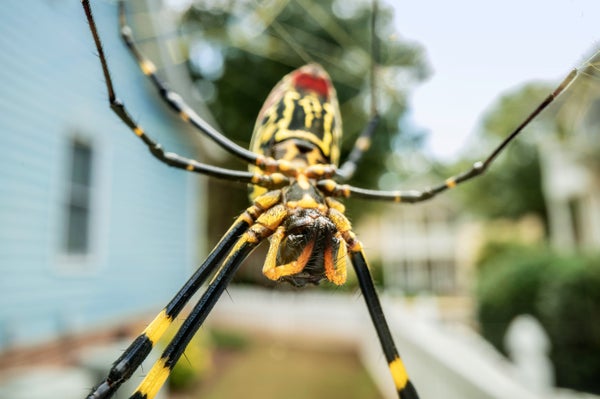Secret to Joro Spiders’ Success May Be Their Ability to Stay Chill

August 12, 2024
4 min read
Invasive Joro Spiders Keep Their Cool Even When Stressed
Compared with other arachnids, invasive Joro spiders are calm, cool and collected under stress, a new study shows
A Joro spider hangs out in a Georgia suburb.
Kelly vanDellen/Alamy Stock Photo
Joro spiders, the East Asian species that is creeping across the eastern U.S., are notable for their willingness to build three- to 10-foot webs in busy suburban and urban areas. Now researchers find that these spiders may owe their tolerance for city bustle to a physiological tendency toward equilibrium.
With a yellow-and-black body that can be more than an inch long and a leg span that can reach a spindly four inches, Joro spiders (Trichonephila clavata) look intimidating. They likely hitched a ride from East Asia to the U.S. in shipping containers about a decade ago and were first observed in Georgia in 2014. Since then they’ve spread to other states, including North and South Carolina, Tennessee and Maryland, and their physiology and native range suggests they’ll eventually thrive as far north as Canada.
The new research suggests the spiders’ chill attitude might facilitate their East Coast trek to domination. Compared with other spider species, Joros maintain an even, albeit high, heart rate under stress, according to a new paper, which was published on August 12 in the journal Physiological Entomology. “They do react to these daily stressors that they see,” says Andy Davis, a research scientist at the University of Georgia, who led the study. “It’s just that they can handle that stress.”
On supporting science journalism
If you’re enjoying this article, consider supporting our award-winning journalism by subscribing. By purchasing a subscription you are helping to ensure the future of impactful stories about the discoveries and ideas shaping our world today.
Because these spiders live near humans and with one another—they sometimes build and inhabit communal webs, the arachnid equivalent of an apartment complex—Davis initially wondered if Joros simply didn’t get stressed. To find out, he focused on spider “heart” rate. Spiders have a central vessel in their abdomen that works much like a human heart, pumping a bloodlike fluid (called hemolymph) throughout the body. When the arachnids are freaked out, this vessel pumps faster.
To get a baseline heart rate, Davis first tried to equip spiders with heart rate sensors in the wild. But he couldn’t get reliable measurements. So he brought the spiders into his lab, where he built them frames on which they could craft webs and then chill out. Once the animals were acclimated to their new situation, Davis aimed a horizontally mounted microscope at their abdomen, counting the visible heartbeats while the spiders were at rest.
The researchers used the same method to study 22 Joro spiders, as well as 20 golden silk orb weaver spiders (Trichonephila clavipes), a North American species in the same genus. For comparison, they also studied 19 yellow garden spiders (Argiope aurantia) and 18 banded garden spiders (Argiope trifasciata), both web-weaving spiders that prefer undisturbed environments.
To stress the spiders, Davis’s co-author, then undergraduate student Christina Vu, restrained them with a forest of pins, threading them between the spiders’ legs and over their abdomens so that the spiders could wiggle around but not move from the spot. “That was something,” Vu says. The Joros and orb weavers were docile, she says, but the garden spiders fought hard. “There were a couple times I released a few spiders because I didn’t move fast enough,” she says. (All the spiders were released back into the wild after the study.)
Still Vu and Davis found that the Joro spiders were not immune to stress. Their heart rate doubled when they were restrained, a result no different than that of orb weavers and banded garden spiders. (Yellow garden spiders’ heart beats triple time.) The heart rats of all the spider species stayed high the whole time they were restrained, never returning to a calm resting rate. Compared with the garden spiders, however, the Joro spiders and golden silk orb weavers had less-variable heartbeats during the 10-minute experiment: while their heart pumped fast, the rate stayed high and steady rather than high with lots of spikes and drops, as seen in the two garden spider species.
“The Joro spiders, just in general, seem very chill,” Vu says. “They’re not going to fight back; they’re really just taking things as they come, which, I think, is why they do much better around people. They don’t seem to react as much, so they can handle more.”
This finding complemented 2023 research by Davis’s lab, which found that Joro spiders freeze for up to an hour when disturbed by puffs of air, much longer than other spider species. In both the cases of restraint and disturbance, the Joros seem more likely than other species to wait out a problem rather than fight or flee.
“We see some spiders that are more urban-tolerant [and] some spiders that are less urban-tolerant, so if you can start to uncover the physiological or behavioral differences, that can start to help us understand more about the species ecology,” says Erin Grabarczyk, a biologist at Valdosta State University in Georgia, who was not involved in the study but has researched Joro spider ecology. It would be interesting to study differences within the species, Grabarczyk adds, noting that individual spiders in Davis’s study seemed to have varying stress responses.
To confirm the link between physiology and lifestyle, researchers will have to study more species, Davis says. He also wants to study Joro spiders who live solo versus those who live communally.
“If you’re a spider, and you’re living in a world filled with daily or hourly stressors, you can’t flee every time one comes by,” Davis says. “This might be a way to deal with all of those stressors.”